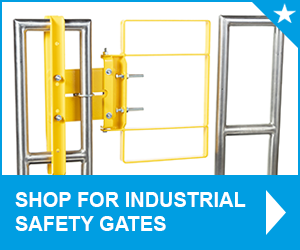
According to the United States Bureau of Labor and Statistics, there were over 300 thousand cases of nonfatal fall-related workplace injuries in 2019. As a manager of a facility where the risk of dangerous falls and other accidents is a daily concern, you have to take the safety of your employees, contractors, and visitors seriously. The equipment you put in place, the training you implement, and the processes and OSHA regulations you follow to provide fall protection are vital to the well-being of your people and your business.
You would never knowingly expose your personnel to avoidable risks, just as they would never intentionally have a dangerous accident in the workplace. But workplace fall accidents can and do happen with the slightest lapse of attention, or by a worker unknowingly failing to do something as simple and familiar as properly closing an indoor swing gate that they use several times a day.
Knowing the workplace areas that commonly require fall protection and the OSHA guidelines that pertain to them is the foundation of a responsible approach to fall safety. This article will highlight the particular advantages of using self-closing safety gates to help minimize the risk of accidents due to distraction, forgetfulness, and other human error.
Why Install a Self-Closing Gate?
The number one reason to choose a self-closing gate over a manual safety gate is that they provide near-continuous protection through the course of a worker’s day.
A manually closing safety gate requires a worker to physically close the gate after they walk through it. This simple step may be overlooked when a worker is carrying a heavy load or pushing themselves to complete a task quickly. That leaves the gate open for themselves, or the next worker, to fall through, eliminating the protection the gate is intended to provide.
A self-closing gate, on the other hand, automatically closes after a worker passes through it. This near-endless protection helps to keep the walkways, stairs and other areas of your facility where such swing gates are installed fully protected from risks of falls. And since it doesn’t require a follow up visit from a worker to close the gate as they perform their tasks, it helps keep performance up and workers on task.
Regulations on the Use of Self-Closing Gates

The Importance of Access Control
Another benefit of self-closing safety gates is access control, an important factor in achieving workplace fall protection. Falls from dangerous heights are a leading cause of workplace injury, so controlling where and how personnel can access hazardous areas of the work environment is often the key to minimizing those risks.
Some of the simplest and most effective ways to manage both physical access to areas and the attentiveness of employees during tasks are passive protection systems, such as guardrails and swing gates. In many cases, it makes a lot of sense (and often is required by OSHA) for those gates to have self-closing mechanisms.
Steps to Take in Safeguarding your Workplace
Even the best self-closing interior swing gates are just one part of a comprehensive safety approach:
- Ensure constant compliance with all relevant OSHA requirements and guidelines. This is the single best way to increase safety and avoid costly fines.
- Carry out regular analysis to determine which areas of your building might require protection they do not currently have. It is important to keep in mind that safety regulations may change over time.
- Identify and eliminate all hazards and implement proper maintenance and cleaning processes to keep your workplace clean and safe.
- Regularly provide and require training for all personnel to keep your workforce educated on fall hazards, equipment usage, and relevant work safety protocols.
Getting the Right Gates
With all the factors that apply to each work location and safety application, there is no one-size-fits all for self-closing gate solutions. You should seek out highly rated manufacturers and consult with an experienced partner. A leader in safety gate systems, Fabenco offers self-closing indoor swing gate models with stellar features such as:
- Easy installation on all standard rail systems
- Stainless steel spring self-closing mechanisms
- Hands-free opening on most models.
- Available in galvanized or powder-coated steel as well as stainless steel and aluminum.
A wide range of self-closing indoor swing gate models are available to fit your needs and your budget. For example, the XL series features an additional top and bottom and bar to match the OSHA mid-rail and top-rail heights. The low-cost R series serves as the metal alternative to plastic safety gates, easily mounting into already existing plastic gates in both holes.
The fall protection specialists at Fabenco are ready to work with you to ensure the safety of your facility and your employees. Contact us today.





